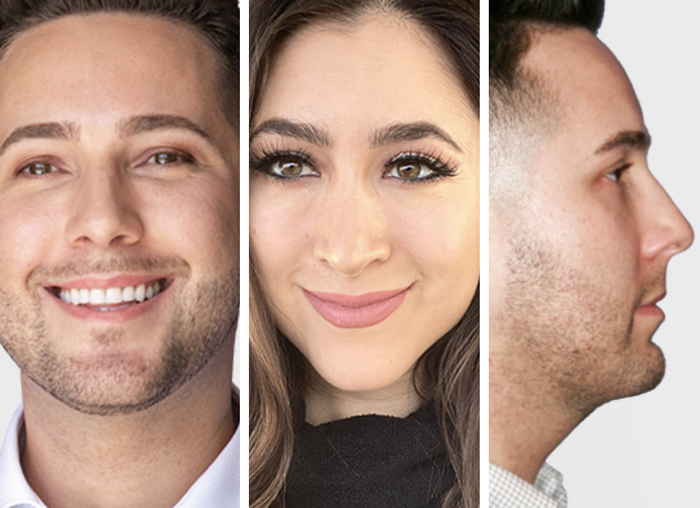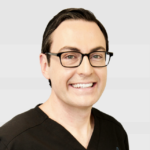A combination of life-long ultraviolet damage (UVA and UVB) from sunlight, plus age-related changes in the skin, can lead to fine lines (rhytids) in the facial skin and many different issues with pigmentation or discoloration. Fine lines are frequently prominent in the area around the eyes (crow’s feet) and may become more obvious with facial movement (such as smiling, laughing, etc.). In mild cases and younger patients, Botox may be sufficient to treat this issue. In more advanced cases, however, these lines are visible at rest and may extend into the cheek area. For these patients, skin resurfacing is required, and Dr. Ransom offers the latest in laser technology to suit all skin types and specific needs.
In some patients, a similar issue arises in the area around the mouth (perioral), causing fine lines (rhytids) that radiate away from the lips like the spokes of a wheel. These are sometimes referred to as “lipstick bleed lines” because they may permit small amounts of lipstick or lip liner to run onto the face. Lines around the mouth are of variable depth – many are shallow, like those around the eyes, but others may be very deep (particularly in smokers). Treatment of lines in this area often requires multiple modalities and sometimes multiple treatment sessions, depending on each patient’s unique anatomy.
Explore our
Patient Gallery
*Actual patients in photos

Lasers can also treat many pigmentation issues, including brown or purple spots (dyschromia) and visible tiny blood vessels (telangiectasias). By removing the top layer of the skin (epidermis), the laser can take away these spots. (Non-ablative lasers that are specific to the pigments in blood or certain types of “age spots” are also useful.) The heat from the laser also helps the body form new collagen from the deeper layers of the skin, creating a smoother, more uniform surface color and texture. This is useful in the treatment of many types of scars.
An added benefit of ablative laser resurfacing is the ability to remove some precancerous skin lesions, such as actinic keratoses (on the facial skin) or actinic cheilitis (on the lips). Because the epidermis sloughs off after an ablative laser procedure, areas that may have turned into skin cancer in the future (i.e., that have not penetrated into the dermis below) are removed. Healthy new skin then heals from below.
Depending on your skin type and your available downtime, a single treatment or series of treatments may be indicated. If multiple sessions are required, these are generally spaced out between three and six months, based on the areas being treated and severity of the fine lines, wrinkles, and dyschromia. Dr. Ransom personally administers your laser treatment, making sure that you achieve the best result in the most comfortable and convenient way possible – and with the quickest recovery.
Who is a candidate?
Anyone with signs of facial aging, including fine lines, wrinkles, and pigment irregularity may be a candidate for CO2 laser resurfacing. In addition, the laser can be used to treat scars from injury, prior surgery, or acne. Contraindications for CO2 laser treatments include a history of scar formation from lasers and darker pigmentation of the skin. In these people, there could be undesired changes in the color or texture of the skin that is treated. For most patients, a pre-treatment medical-grade skincare regimen can improve results and reduce the risks of complications. This often includes topical medications to stabilize skin tone and improve the skin’s healing mechanisms. For more information, please see our page about skincare products or contact our office.
Frequently Asked Questions
Please note that all patients are different and individual healing times and results may vary. The statements regarding procedures and recovery made here are general rules.
Recovery time after your laser treatment depends on a number of factors, including the depth and intensity of the treatment, the areas treated, and your specific skin type and healing process. Following the laser treatment, patients use topical emollients and soaks to assist in healing and improve the results. Downtime is typically less than a week, and may be as quick as three days!
Multiple anesthesia options are available for laser resurfacing. This includes local anesthesia only, light sedation, or general. In most cases, patients are able to have laser treatments with topical numbing medicines and local anesthesia blocks. For deeper treatments, light sedation is common. This may include oral medications for pain and anxiety, or similar medicines delivered through an IV. Dr. Ransom will discuss the most appropriate option for your case during your consultation.
Dr. Evan Ransom is an Ivy League-educated and Ivy League trained Facial Plastic and Reconstructive Surgeon. He is a Double Board Certified Head and Neck Surgeon and Facial Plastic and Reconstructive Surgery and fellowship-trained in facial plastic, reconstructive, and laser surgery. His practice is in the San Francisco Bay Area, serving patients from San Francisco, Oakland, Marin County, Palo Alto, Silicon Valley, Walnut Creek, the East Bay, and all over Northern California.
 (415) 550-1077
(415) 550-1077 San Francisco
San Francisco




